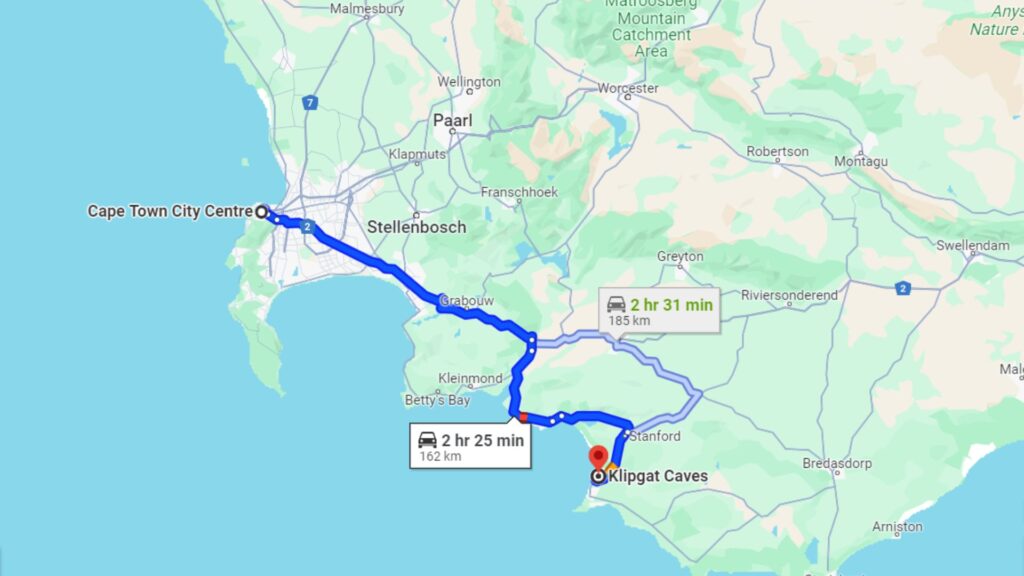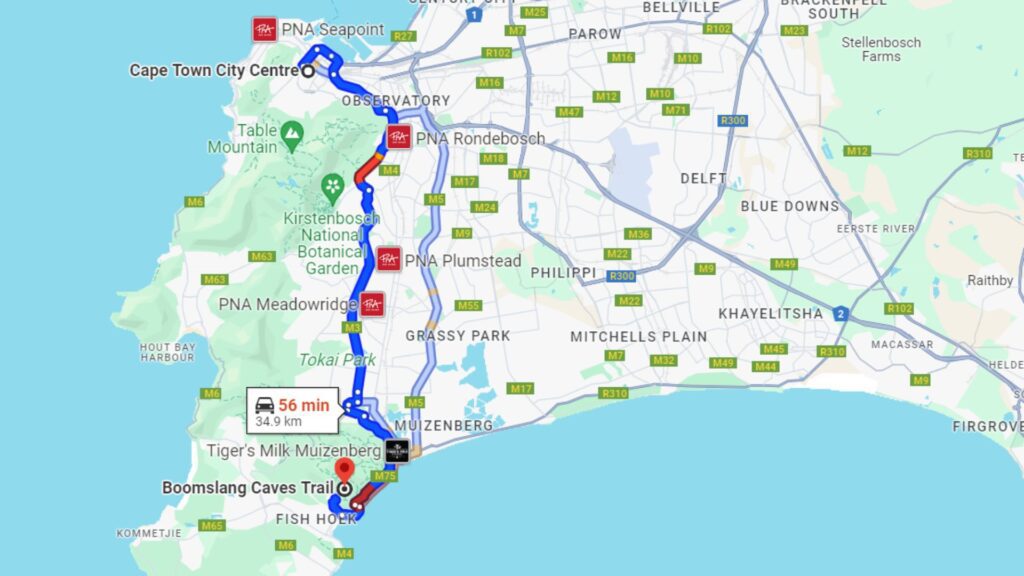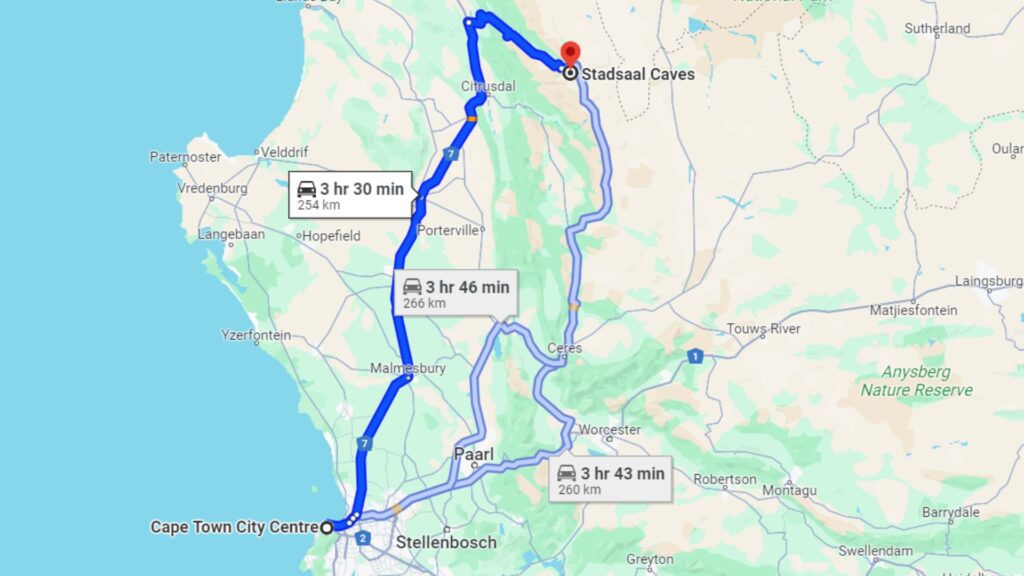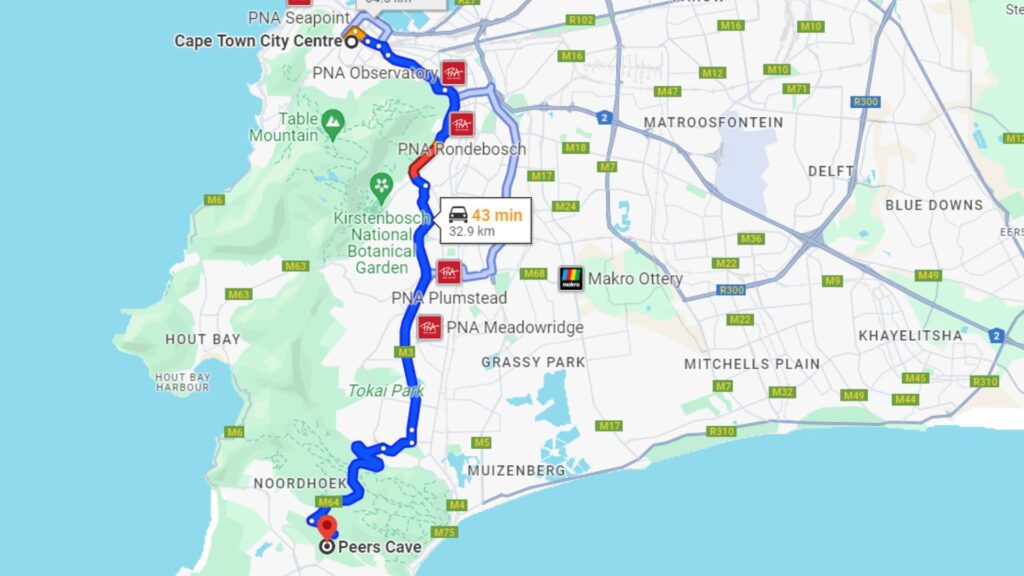For me, a cave is one of the most magical places – a home carved for us by Mother Nature herself. I can only begin to imagine the stories their walls would tell if they could talk.
Embarking on a quest to explore the captivating caves of Cape Town felt like stepping into a world where nature’s artistry takes over. These mystical caverns, sculpted over millennia, beckon adventurers to unveil the secrets woven into their very walls.
Join me on this expedition in Cape Town as we delve into the heart of these hidden gems, each with a story waiting to be discovered and each with an equally beautiful view to behold.
Table of Contents
1. Best For An Adventurous Hike: Klipgat Cave

This is definitely a cave that is close to my heart, as well as my home in Hermanus. The walk is along the breathtakingly beautiful ocean, and you can smell the fynbos the entire way.
On top of this, the cave is a historical site! In 1992, archaeologists came across the remains of some of the earliest Home Sapiens. Sitting inside the cave on its rocky floor, I could only imagine how many people before me had done the same thousands and thousands of years ago.
The fact that the remains were discovered as recently as 1992 makes me wonder if there is any more in the area waiting to be found…
- What makes it special? This cave has two chambers, so you’ll have twice as much to explore.
- Location: Kipgat Caves, Gansbaai
- How to get to the cave:
- You can take the N2 from Cape Town to Gansbaai.
- Start walking from the Gansbaai Harbour and enjoy the scenic 7 km trail to the cave.
- However, if you’re not in the mood for extra cardio, you could also drive to Walker Bay Nature Reserve from Hermanus (we sometimes do this if we’re pressed for time but still want to make it to the cave in time for sunset). Don’t be fooled, even though it is a shorter walk along the boardwalk, it can still be pretty tiring!
- Tip: Plan to do this hike during low tide! Or else you’ll end up with very wet shoes.
2. Best For An Easy Hike: Boomslang Cave

The path leading to Boomslang Cave is a picturesque trail through lush vegetation, with the gentle sounds of nature providing the perfect soundtrack for a Sunday outing. During my exploration, I found myself captivated by the tranquillity of the surroundings, making this short hike a perfect escape from the hustle and bustle of city life.
Despite this hike to Boomslang Cave being about 2 hours long, it’s an easy trail that even children will be able to do! Things did get a little interesting towards the end when I had to get down on all fours to move through the tunnels, but it was all worth getting my hands a little dirty when I saw the jaw-dropping views of Noordhoek Valley and the False Bay coast.
- What makes it special? There are loads of bats living here! So not only will you get to see a captivating cave and tunnels carved by nature, but also a few little vampires hanging upside down. Just be careful not to disturb them.
- Location: Boomslang Caves Trail, Clovelly, Cape Town
- How to get to the cave:
- Ascend Boyes Drive until you encounter a sign directing you towards Echo Valley.
- Proceed on the trail until you arrive at the expansive crevice leading to the entrance of Boomslang Cave.
- Another route entails a hike through the picturesque Silvermine Nature Reserve, starting from the Ou Kaapse Weg side.
- Tip: Bring a flashlight! If you’re planning on sliding through this tunnel to explore further, you will need some light as it can get pretty dark.
3. Best For History And Archaeology: Stadsaal Cave

The 3.5-hour-long drive from Cape Town CBD was an adventure in itself, winding through picturesque landscapes that hinted at the ancient tales hidden among the rocky crevices. The cave is easily accessible from the parking lot. Once you’ve arrived, you’ll find a series of caverns that have been carved by weather and Mother Nature over thousands of years.
Exploring Stadsaal Cave was like stepping back in time. The vivid rock paintings (said to be 1,000 years old) depicting the daily lives and rituals of the San people left me in awe of their rich cultural heritage.
- What makes it special? Stadsaal Cave is a gallery of rock art, showcasing the daily lives, rituals, and beliefs of the San people. These paintings are exceptionally well-preserved thanks to the ochre rock the bushmen used to paint with.
- Location: Stadsaal Caves, Cederberg Wilderness Area, West Coast DC, Western Cape
- How to get to the cave: Even though it’s not just around the corner, it’s well worth it!
- Embark on a scenic drive from Cape Town to the Cederberg Wilderness Area.
- Stadsaal Cave is easily accessible.
- Just a short walk from the parking area reveals the mesmerising rock art within. Be prepared to be transported back in time as you explore the stories etched on the cave walls.
- Tip: The Cederberg area is a nature reserve that requires visitors to have permits. It costs R70 for adults and R40 for children at the time of writing. You can buy these permits from either the Driehoek Farm on the way or from CapeNature (021 483 0190).
4. Best For Panoramic Views: Watchman’s Cave

The moderate hike to Watchman’s Cave led me through a diverse landscape, from shaded forests to open trails with glimpses of the unfolding scenery. As I ascended, the allure of the panoramic views was what kept me motivated to push through.
Since this cave is on Lion’s Head, I expected it to be bustling with tourists (the main trail usually is) but was happy to find that we were the only ones there. My partner and I enjoyed one of the best sunsets I’d ever seen from our sheltered, little cave.
- What makes it special? The panoramic views of the city are something you will have to witness for yourself. I consider it to be quite the hidden gem as well. Since most people usually hike directly up to the summit of Lion’s Head, they tend to miss other beautiful spots, like this one, on their way.
- Location: Lion’s Head Hiking, Signal Hill Rd, Signal Hill, Cape Town
- How to get there: This cave can be found just above the main trail on Lion’s Head. It’s a bit of a hike to get there but well worth the adventure on a summer evening.
- Tip: Pack a picnic and savour the scenery from the elevated vantage point within the cave. The cave provides a cosy nook to enjoy a meal while surrounded by the unmatched beauty of the landscape.
5. Best For Ancient Rock Art: Eland’s Bay Cave

Being in Elan’d Bay Cave was like visiting a museum made by nature. I felt like I was part of a special journey back in time, getting to see and appreciate the amazing art left behind by the people who came before me.
In 2009, the cave was rightfully declared a provincial heritage site, making it a unique gem on the entire West Coast.
- What makes it special? Elands Bay Cave boasts an extraordinary concentration of heritage resources, making it a one-of-a-kind destination in the region. This spot between the Cape Peninsula and Orange River offers breathtaking views, a rarity along the coast, where the mountains meet the sea.
- Location: Elands Bay Cave, Elands Bay
- How to get there:
- Easily accessible by road from Cape Town, the journey to Eland’s Bay Cave unveils the cultural riches hidden within the cave’s depths. I
- t is a short walk from the parking area to the Eland’s Bay Cave entrance, offering a glimpse into the artistic legacy of the San people.
- Tip: There can be quite a few snakes on this trail so just be cautious with you’re footing!
6. Best For A Short Hike: Peers Cave

I consider Peers Cave a “secret” (but also a not-so-secret) cave in the Mother City. With one of the most glorious Cape Town sunsets, this is a gem of a cave that you can’t miss out on.
Did you know that it’s named after a man called Victor Peers, who found a 13,000-year-old human skull at the spot where locals and tourists now enjoy picnics? Well, now you do!
It is crazy to think that humans have been doing the exact same hike as I did (and you can do) thousands of years ago. I can only imagine that the view of Noordhoek at the top must just have been very different back then.
- What makes it special? Beyond its accessibility, Peers Cave holds archaeological treasures that echo the tales of its early inhabitants. Archaeological excavations have revealed artefacts dating back thousands of years, providing a captivating glimpse into the lives of those who once sought shelter within its rocky walls.
- Location: Peers Cave, Silvermine Rd, Fish Hoek, Cape Town
- How to get to the cave:
- Situated in the Silvermine Nature Reserve, reaching Peers Cave is a breeze.
- Start your journey by heading towards Silvermine Nature Reserve.
- A well-marked path guides you to the Peers Cave entrance.
- It’s a manageable trail, making it an ideal choice for a leisurely hike that doesn’t compromise the experience with steep uphills or challenging terrains.
- Tip: Don’t hike alone! There have been reports of muggings in the area so just be vigilant and stick to your group.
FAQs
What is the largest cave in the Western Cape?
The largest cave in the Western Cape is the Cango Caves, located near Oudtshoorn. It is a system of caves with over 4 km of passages and chambers and is home to a variety of unique geological formations, including stalactites, stalagmites, and flowstones.
The Cango Caves are also a popular tourist destination, offering guided tours that take visitors through some of the most spectacular parts of the cave system.
Are there caves on Table Mountain?
Yes, there are several caves on Table Mountain. Some of the most well-known caves include:
- Woodstock Cave
- Elephant’s Eye Cave
- Rendezvous Cave
- Boomslang Cave
What is the oldest cave in Cape Town?
Elands Bay Cave is one of the oldest caves in Cape Town, located in Elands Bay. This cave is home to some of the most well-preserved examples of San rock art in South Africa, and the paintings are estimated to be around 5,000 years old. The rock art depicts animals, humans, and geometric patterns, providing a glimpse into the lives of the people who lived in the area many years ago.
There are also other older caves outside of the city, like the Blombos Cave.





